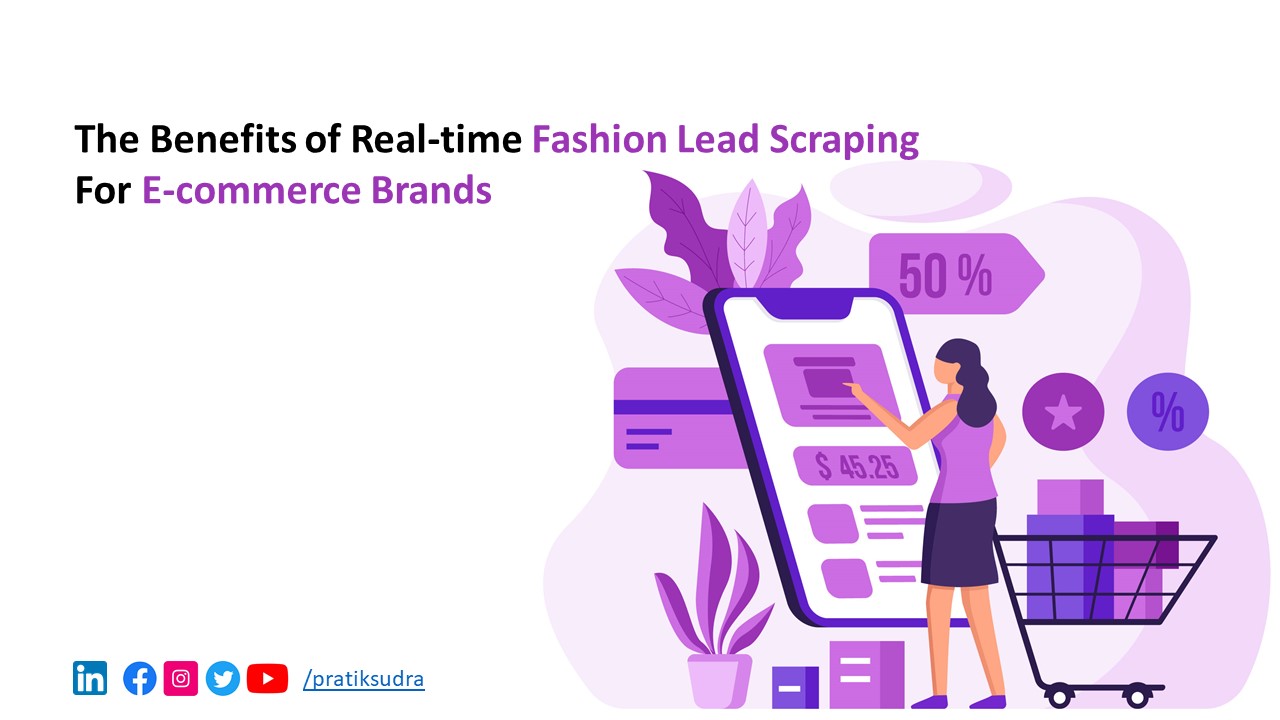Synopsis:
In the world of e-commerce, real-time fashion lead scraping has become a powerful strategy for driving customer engagement and increasing sales. This blog explores the benefits of implementing real-time fashion lead scraping for e-commerce brands and provides a phased approach to its implementation, along with the necessary tools.
The blog begins by emphasizing the importance of research and planning, including identifying the target audience and defining the data requirements. It then delves into the data extraction and organization phase, highlighting the selection of lead scraping tools and identifying relevant data sources. The blog further explains how to extract and store data in a CRM system for efficient management and analysis.
Personalized outreach and marketing take center stage in the next phase. The blog emphasizes the significance of data analysis and segmentation to craft tailored marketing campaigns. It discusses the use of automation tools to streamline and scale personalized outreach efforts effectively.
Introduction:
In the highly competitive world of e-commerce, finding effective ways to generate leads and connect with potential customers is crucial for success. One powerful strategy that e-commerce brands can leverage is real-time fashion lead scraping. By extracting valuable customer data in real-time, brands can gain a competitive edge, personalize their marketing efforts, and drive conversions. In this blog, we'll explore the benefits of real-time fashion lead scraping and provide a phased implementation approach with the necessary tools.
Phase 1: Research and Planning
-
Identify the target audience: Determine the specific demographics and preferences of your target audience within the fashion industry. This will help in refining your lead scraping efforts.
-
Define data requirements: Determine the specific data points you need to extract, such as email addresses, social media handles, purchasing behavior, or product preferences.
Phase 2: Data Extraction and Organization
-
Select lead scraping tools: Popular tools like BeautifulSoup, Scrapy, or Octoparse can assist in scraping data from websites, social media platforms, and other online sources.
-
Identify relevant data sources: Research fashion blogs, social media communities, online forums, and e-commerce platforms where your target audience is active. These sources will provide rich and up-to-date customer data.
-
Extract and store data: Utilize the selected tools to scrape and extract data in real-time. Organize the data in a CRM system or database for efficient management and analysis.
Phase 3: Personalized Outreach and Marketing
-
Data analysis and segmentation: Analyze the extracted data to identify patterns, preferences, and behavioral insights. Segment your leads based on demographics, interests, or previous interactions with your brand.
-
Personalize marketing campaigns: Craft tailored email campaigns, social media engagement strategies, and targeted advertisements based on the data insights. Deliver relevant content and offers that resonate with each segment of your leads.
-
Automate workflows: Use automation tools like email marketing platforms or customer engagement software to streamline and scale your personalized outreach efforts.
Phase 4: Continuous Monitoring and Optimization
-
Track campaign performance: Monitor key metrics such as open rates, click-through rates, conversions, and customer engagement to evaluate the effectiveness of your lead scraping efforts.
-
A/B testing: Experiment with different messaging, visuals, and offers to optimize your marketing campaigns further. Test different subject lines, call-to-actions, or personalized recommendations to find what resonates best with your leads.
-
Iterate and refine: Regularly analyze the collected data, customer feedback, and campaign results to refine your lead scraping strategies and continuously improve your marketing efforts.
Example Implementation: E-commerce Fashion Brand Y
E-commerce Fashion Brand Y specializes in affordable and trendy fashion for young adults. They want to implement real-time fashion lead scraping to drive customer engagement and boost sales. Let's explore how they can implement and optimize their lead scraping strategy using the guidelines mentioned in the blog.
Phase 1: Research and Planning
-
Identifying the target audience: Fashion Brand Y defines their target audience as fashion-forward individuals aged 18-35 who are interested in affordable and trendy fashion.
-
Defining data requirements: They decide to extract email addresses, social media handles, and purchasing behavior data from their leads.
Phase 2: Data Extraction and Organization
-
Selecting lead scraping tools: Fashion Brand Y chooses a combination of BeautifulSoup and Octoparse as their lead scraping tools due to their flexibility and ease of use.
-
Identifying relevant data sources: They research popular fashion blogs, fashion communities on social media platforms, and online fashion marketplaces where their target audience is likely to engage and make purchases.
-
Extracting and storing data: Fashion Brand Y uses their selected tools to scrape real-time data, including email addresses and social media handles, from their target sources. They store the data in a CRM system, categorizing leads based on demographics and preferences.
Phase 3: Personalized Outreach and Marketing
-
Data analysis and segmentation: Fashion Brand Y analyzes the collected data to identify patterns and preferences among their leads. They segment their leads based on age, style preferences, and purchase history.
-
Personalized marketing campaigns: Based on the data insights, Fashion Brand Y crafts personalized email campaigns that feature relevant product recommendations and exclusive discounts. They also engage with their leads on social media by sharing fashion inspiration and styling tips.
-
Automating workflows: To scale their efforts, Fashion Brand Y utilizes an email marketing platform to automate their email campaigns. They use social media management tools to schedule posts and engage with their leads consistently.
Phase 4: Continuous Monitoring and Optimization
-
Tracking campaign performance: Fashion Brand Y tracks key metrics like open rates, click-through rates, and conversion rates to measure the effectiveness of their personalized marketing campaigns.
-
A/B testing: They conduct A/B tests on different subject lines, email layouts, and call-to-actions to identify the most effective variations. They also experiment with different visuals and messaging on social media to optimize engagement.
-
Iterating and refining: Fashion Brand Y regularly analyzes the data collected, customer feedback, and campaign results. They use these insights to refine their lead scraping strategies, update their target audience profiles, and improve their marketing efforts.
By implementing real-time fashion lead scraping and following the guidelines mentioned in the blog, Fashion Brand Y successfully engages with their target audience, drives customer engagement, and increases sales. They continuously optimize their strategy by monitoring campaign performance, conducting A/B tests, and refining their messaging and targeting. This allows them to stay relevant, deliver personalized experiences, and build strong connections with their customers.
Conclusion: Real-time fashion lead scraping empowers e-commerce brands to tap into a wealth of valuable customer data and leverage it for personalized marketing campaigns. By implementing a phased approach and using the right tools, brands can extract data in real-time, segment leads, personalize outreach efforts, and optimize their marketing strategies for maximum conversions. The benefits of real-time fashion lead scraping include increased customer engagement, higher conversion rates, improved brand loyalty, and a competitive advantage in the e-commerce industry. Embrace the power of real-time lead scraping and unlock the potential of your e-commerce brand.
Remember, compliance with data privacy regulations and ethical data usage practices is essential when implementing lead scraping strategies. Always ensure that you adhere to applicable laws and regulations to protect your customers' privacy and maintain a trustworthy brand image.


